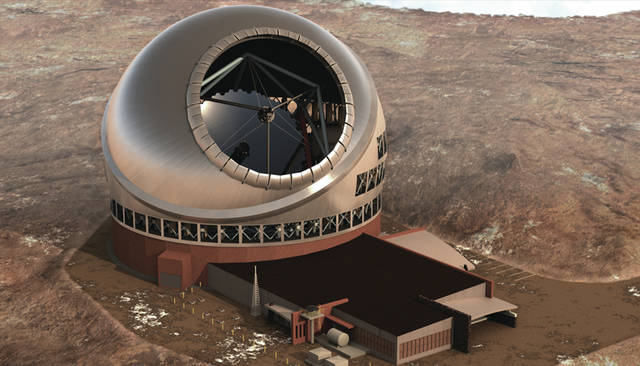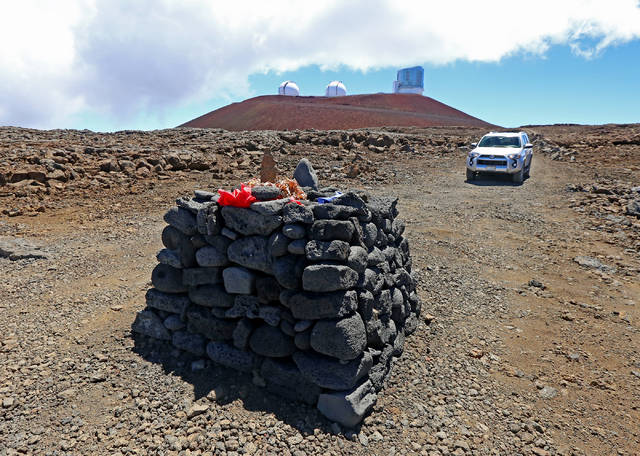TMT permit approved — with caveats
HILO — The state Land Board will require the University of Hawaii to remove three telescopes atop Mauna Kea and create new educational programs as conditions for allowing construction of the Thirty Meter Telescope.
The board announced Thursday it approved a construction permit for the next-generation observatory in a 5-2 vote following a monthslong contested case hearing.
The condition requiring removal of some telescopes “as soon as reasonably possible” was part of Gov. David Ige’s 10-point plan for the mountain that previously received the consent of the university, which manages the Mauna Kea Science Reserve. Those three areas would be excluded from future development. UH says TMT would be the last new telescope site.
“Following this approval, (TMT International Observatory) will continue to respect state procedures and to comply fully with applicable legislation and regulation,” TIO board chairman Henry Yang said in a statement. “In moving forward, we will listen respectfully to the community in order to realize the shared vision of Maunakea as a world center for Hawaiian culture, education and science.”
The board adopted the recommendation and findings of hearing officer Riki May Amano, a retired judge who oversaw the quasi-judicial hearing, along with other added conditions. Board members Stan Roehrig and Keith Downing voted no.
Supporters say the observatory would keep Hawaii at the forefront of astronomy but it is strongly opposed by some Native Hawaiians who consider Mauna Kea sacred and environmentalists who say the mountain is overdeveloped.
Kealoha Pisciotta, a TMT opponent and contested case petitioner, alleged the board cut corners by not issuing a response to each of the two dozen parties’ proposed findings and allowing the hearing officer to “cut and paste” arguments from the university. She said the decision will be appealed to the state Supreme Court.
“I am surprised that they would put this many people through the same hearing all over again and repeat the same errors that the court just found unlawful,” Pisciotta said.
The appeal would be the second time the high court has heard the issue.
In December 2015, it overturned the Land Board’s previous approval of the permit because it initially voted in favor before holding the first contested case. That prompted a second hearing that ended earlier this year.
The project lost its sublease with UH last December when Hilo Circuit Judge Greg Nakamura ruled the Land Board should have granted a separate contested case before making that decision. The state is appealing that ruling to the state Supreme Court, leaving construction unable to resume at least until that issue is resolved.
TIO spokesman Scott Ishikawa said the organization would “look at its options” before deciding when to resume building, assuming the high court rules in its favor on both issues.
The TIO board, which is considering the Canary Islands as an alternative site, has set April 2018 as a deadline to resume construction.
“We’re very pleased with the way this project is moving forward and Mauna Kea remains our top priority,” Ishikawa said.
The new conditions also include a requirement that UH-Hilo and TIO develop early entry programs for “at-risk children of Hawaiian ancestry and other at-risk youth” in science, engineering, navigation and Hawaiian language.
Additionally, UH-Hilo must create an internship program for the astronomy facilities, allow the Hawaiian language program to use the midlevel facilities on Mauna Kea and consider accommodations for Hawaiian products at the visitor information station.
While acknowledging the cultural significance of Mauna Kea, the board rejected arguments made by opponents who said the 180-foot-tall observatory would interfere with religious practices.
“Some groups perform ceremonies near the summit,” the board wrote in the decision’s preface. “The evidence shows that these ceremonies began after the summit access road and first telescopes were built, but, in any case, the TMT will not interfere with them.” The observatory would not be visible from the summit at Pu‘u Wekiu, the board said.
Pisciotta said those findings were “beyond disappointing.”
“Our hearing was filled with witnesses, and these are cultural practitioners and academics, that came forward to testify not only to how the project will impact their practices but how the project impacts the Hawaiian people as a whole,” she said.
The board also said the observatory, which would be built below the summit at about 13,100 feet above sea level, would not pollute groundwater or damage historic sites.
The Hilo-based nonprofit Perpetuating Unique Educational Opportunities proposed the additional educational programs that were added as a condition.
PUEO President Keahi Warfield said he was happy to see that added but at the same time was disappointed the group’s proposal for a cultural and educational center on the mountain wasn’t included. He said the group would continue to pursue that goal.
“We’re trying to find the best possible solution for everyone,” Warfield said. “That’s the hard part. People see it as a compromise but in today’s time we got to look out for the big people and the little people. And I think that is a cultural tradition, making sure everyone is well taken care of.”
In response to protests in 2015 that halted construction then, Ige proposed his plan and asked UH to reduce its overall impact on the mountain, which hosts 13 telescopes.
UH then selected UKIRT, which it owns, and UH-Hilo’s Hoku Kea teaching telescope to be decommissioned early to meet that target. The Caltech Submillimeter Observatory ended operations in 2015 and will be removed.
The permit conditions also require two additional observatories be decommissioned by Dec. 31, 2033, when UH’s master lease ends, with the Very Long Baseline Array being one of them. UH intends to seek a new lease.
The selection of Hoku Kea, the smallest telescope on the mountain, to be removed prompted pushback from members of the Hilo community, including PUEO. The Office of Mauna Kea Management’s board paused decommission of the telescope to allow for further consultation.
UH-Hilo has a replacement 28-inch telescope and dome in hand, but its future home remains undetermined.
Ige said during a press conference Thursday in Honolulu that the review process for TMT was thorough and he is glad it can move forward.
“The contested case allowed those who wanted to voice their opinion to voice their opinion,” he said. “I think Judge Amano did a good job to allow all the parties, the opponents, to have a say and provide their statements and the evidence that they wanted.”
The hearing, which included 44 days of witness testimony, cost the state as much as $483,619, according to the Department of Land and Natural Resources.
As leaseholder of the land, UH was the permit applicant on behalf of the $1.4 billion project.
“The university first applied for this permit seven years ago, and we believe this decision and the underlying vote represent a fitting and fair reflection of an issue that has divided many in the community who care deeply about Maunakea,” UH said in a press release.
“Maunakea is precious to all of Hawaii, and we know that science and culture can synergistically coexist there, now and into the future.”
TIO is paying $1 million per year for educational programs on Hawaii Island and will pay rent that will top out at about $1 million after a decade. Eighty percent of the lease payments would go to the Office of Mauna Kea Management while the Office of Hawaiian Affairs would receive 20 percent.
The project would create as many as 140 permanent jobs and more than 100 construction jobs, according to the Land Board. The telescope would see more than 13 billion light-years away.
The board made its decision just more than a week after hearing testimony from contested case participants on Amano’s proposed order, issued last July. State law allows the board to vote and deliberate in closed-door meetings for quasi-judicial hearings, according to the state Office of Information Practices.
Email Tom Callis at tcallis@hawaiitribune-herald.com.




